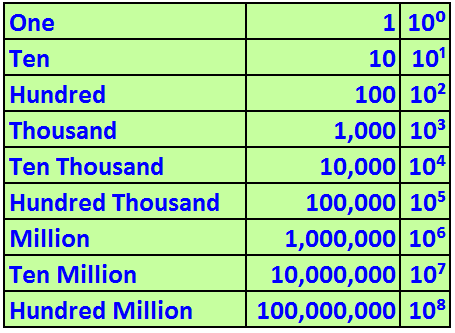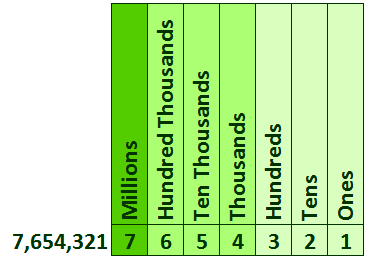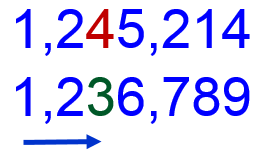Also the neutral number zero
Operations with Signed Numbers
- If the signs of the numbers are the same, ADD. The answer has the same sign.
- If the signs of numbers are different, SUBTRACT. The answer has the sign of the larger number.
Add_ and_Subtract_Integers
Addition and Subtraction of Signed Numbers
Adding, Subtracting Integers Help
Multiply_and_Divide_Integers
Prime Numbers. Numbers that can only be divided by 1 and itself and have no remainders.
Prime Numbers = 2, 3, 5, 7, 11, 13, 17, 19, 23, 29, 31, 37, 41, 43,
Composite Numbers. Numbers that can be divided by more than two factors and have no remainders.
Composite Numbers = 4, 6, 8, 10, 12, 14, 16, 18, 20, .
Neutral Numbers. These numbers are not prime nor composite: 0 and 1
Ex. Round to the nearest hundreds
Rounding whole numbers (to the nearest ten, hundred, thousand)
Powers of 10
Powers of 10 can be written in two ways:
• With an exponent: 10³
• In expanded form: 1000 (1000 = 10³, note that the number of zeros is equivalent to the exponent)
Multiplying by a positive power of 10 makes the number larger and multiplying by a negative power of 10 makes the number smaller.
5 x 10¹= 5 x 10 = 50
5 x 10²= 5 x 100 = 500
5 x 10³= 5 x 1,000 = 5,000
5 x 10⁴= 5 x 10,000 = 50,000
To multiply a whole number by a power of ten, just count how many zero you have and attach that to the whole number.
Multiply By Powers of 10
To divide by a power of 10, simply move the decimal point to the left the same number of places as the exponent or as the number of zeros. Example:
50 / 10¹= 50/10 = 5
500/10² = 500/100 = 5
5000/10³ = 5000/1000 = 5
Note: The decimal point of a whole number is always to the right of the one’s place.
Divide By Powers of 10
Positive, negative and zero exponents with a base of ten
1/10000 = 0.0001 = 1 x 10⁻⁴
When we multiply a number by a positive power of 10, we move the decimal point of the number to the right.
When we multiply a number by a negative power of 10, we move the decimal point of the number to the left.
The number of places to move would be equal to the power of ten.
Multiply and divide by positive powers of Ten
Place Value of Whole Numbers
Compare and order Integers
We can compare different integers by looking at their positions on the number line. For any two different places on the number line, the integer on the right is greater than the integer on the left.
Ex. Order 3, 5, -3, 1, -5
When we compare whole numbers we line up place values (so that similar place values are lined up). Start at the left and find the first place where the digits differ.
Example: To compare the numbers 1,245,214 and 1,236,789, we will line up the numbers so the digits in the ones place line up.
Since 4 > 3, We conclude that 1,245,214 is bigger than 1,236,789
Comparing Integers
Comparing Vocabulary
Comparing Symbols Help
Comparing Writing
Standard decimal notation (base 10 notation)
Base 10 refers to the numbering system in common use. When you write “316”, the “3” means 300, the “1” means 10, and the “6” means 6.
This can be written 316 = 3*10² + 1*10¹ + 6*10⁰
Expanded notation
Method of writing numbers as the sum of powers of ten or as the sum of its units, tens, hundreds, etc.
Example: 316 = 3 x 100 + 1 x 10 + 6 =300 + 10 + 6
Scientific notation
Scientific notation is a way of writing numbers too large or small to be conveniently written in standard decimal notation.
For example, instead of writing 65,000,000, we write 6.5 x 10⁷

Scientific Notation
Standard Form











